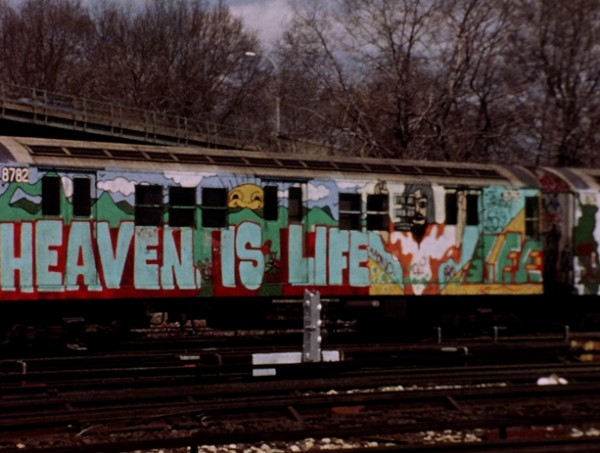
Cult subway graffiti film STATIONS OF THE ELEVATED is being shown in new restoration at BAMcinématek
STATIONS OF THE ELEVATED (Manfred Kirchheimer, 1981)
BAMcinématek, BAM Rose Cinemas
30 Lafayette Ave. between Ashland Pl. & St. Felix St.
October 17-23
718-636-4100
www.bam.org
 Thirty-three years after screening at the New York Film Festival, Manfred Kirchheimer’s Stations of the Elevated is finally getting its official U.S. theatrical release, in a gorgeous new restoration showing at BAMcinématek October 17-23. In 1977, Manfred Kirchheimer, whose family escaped Nazi Germany in 1936, went to the Bronx and filmed graffiti-covered subway cars at the train depot and rushing across the elevated tracks, kids playing in a burned-out housing project, and giant billboards advertising hamburgers, cigarettes, alcohol, and suntan lotion. Shot on 16mm reversal stock, Stations of the Elevated is more than just a captivating document of a bygone era; it is a deeply poetic socioeconomic journey into class, race, art, and freedom of expression, told without a single word of narration or onscreen text. Instead, producer, director, editor, and photographer Kirchheimer (Colossus on the River, Bridge High with Walter Hess) shifts from the natural sound of the environment to a superb jazz score by Charles Mingus while cutting between shots of trains covered in tags and illustrations (and such phrases as “Heaven Is Life,” “Invasion of the Earth,” “Never Die,” and “Earth Is Hell”) by such seminal figures as Blade, Daze, Lee, Pusher, Shadow, and Slave and views of colorful billboards filmed peeking through the geometric architecture of the elevated railways and set against bright blue skies. Most often, the camera focuses on the painted eyes in the ads, looking right back at the viewer as they dominate the scene, evoking the optician’s ad in that famous novel of American class, The Great Gatsby. (The concentration on the eyes also predicts how Madison Ave. was watching the graffiti movement, eventually coopting the imagery into mainstream advertising.) Through this dichotomy of meaning and execution, Kirchheimer reveals similarities in artistic styles and how the elements influenced each other; a particularly telling moment occurs when a man is shown hand painting a billboard who could have just as well been spray painting a subway car.
Thirty-three years after screening at the New York Film Festival, Manfred Kirchheimer’s Stations of the Elevated is finally getting its official U.S. theatrical release, in a gorgeous new restoration showing at BAMcinématek October 17-23. In 1977, Manfred Kirchheimer, whose family escaped Nazi Germany in 1936, went to the Bronx and filmed graffiti-covered subway cars at the train depot and rushing across the elevated tracks, kids playing in a burned-out housing project, and giant billboards advertising hamburgers, cigarettes, alcohol, and suntan lotion. Shot on 16mm reversal stock, Stations of the Elevated is more than just a captivating document of a bygone era; it is a deeply poetic socioeconomic journey into class, race, art, and freedom of expression, told without a single word of narration or onscreen text. Instead, producer, director, editor, and photographer Kirchheimer (Colossus on the River, Bridge High with Walter Hess) shifts from the natural sound of the environment to a superb jazz score by Charles Mingus while cutting between shots of trains covered in tags and illustrations (and such phrases as “Heaven Is Life,” “Invasion of the Earth,” “Never Die,” and “Earth Is Hell”) by such seminal figures as Blade, Daze, Lee, Pusher, Shadow, and Slave and views of colorful billboards filmed peeking through the geometric architecture of the elevated railways and set against bright blue skies. Most often, the camera focuses on the painted eyes in the ads, looking right back at the viewer as they dominate the scene, evoking the optician’s ad in that famous novel of American class, The Great Gatsby. (The concentration on the eyes also predicts how Madison Ave. was watching the graffiti movement, eventually coopting the imagery into mainstream advertising.) Through this dichotomy of meaning and execution, Kirchheimer reveals similarities in artistic styles and how the elements influenced each other; a particularly telling moment occurs when a man is shown hand painting a billboard who could have just as well been spray painting a subway car.
Kirchheimer remains outside during the course of the forty-five-minute documentary, never venturing into the tunnels, capturing the elevated train lines as if they’re just another part of New York City architecture, which of course they are. And it’s especially powerful because it was made at a time when the city was in the midst of a severe economic crisis and rampant crime epidemic, as Mayor Koch sought to eliminate the scourge of graffiti, while Kirchheimer celebrates its beauty (and New York-ness) in this glorious little film. Stations of the Elevated, which elevates the station of subway graffiti artistry with an entrancing calmness, is being shown at BAMcinématek with Claw, Kirchheimer’s 1968 film about urban renewal made with Hess; Kirchheimer, now in his early eighties, will be at BAM to participate in Q&As at the 7:45 screening on October 17 and the 7:00 screening on October 18. In addition, street artist David “Chino” Villorente will make a special presentation at the 8:00 showing on October 21 (in place of Claw).